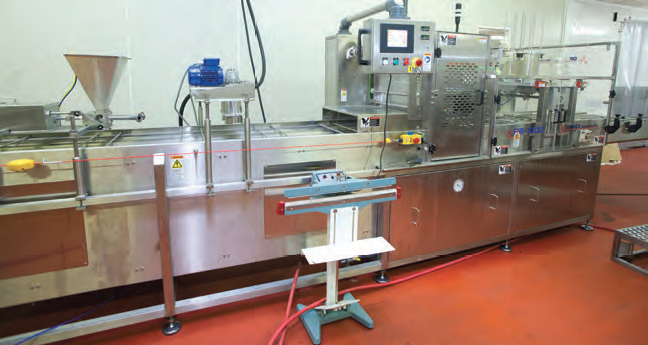Hyde and Hyde is a food processor and distributor based in Cincinnati, Ohio and Corona, California with a packaging facility offering custom packing services as well as packaging its own-label products for supply to the food services market. The company specialises in the production of trays and bags of mixed salad components for the US market.
New machines
[av_icon_box position=’left’ boxed=” icon=’ue8d2′ font=’entypo-fontello’ title='”A single Model PB-1000 can deposit meat, nuts, grated cheese, dried fruit, croutons and even pots of dressing and condiments.”‘ link=” linktarget=” linkelement=” font_color=’custom’ custom_title=’#005ba0′ custom_content=” color=” custom_bg=” custom_font=” custom_border=”][/av_icon_box]
In August 2008 the company upgraded its salad packing line with the installation of a new modified atmosphere packaging (MAP) system, which was also able to increase the speed of the line and improve efficiency and accuracy to speeds of up to 60 trays a minute. The system was a MAP fill-and-seal machine designed to produce trays of ready-to-eat salad meals for a fresh produce supplier creating tray based salad meals.
The Model PB-1000 servo-driven, 4-wide, modified-atmosphere packaging (MAP) machine was supplied by ORICS Industries Inc and has allowed the production of very complex products under modified atmosphere. Salad trays can be complicated, yet a single Model PB-1000 can deposit meat, nuts, grated cheese, dried fruit, croutons and even pots of dressing and condiments into the multi-compartment tray before sealing under modified atmosphere.
The accompaniment trays are then taken to the fresh produce supplier where they are attached to a fresh salad bowl, completing the one-step meal product ready for shipping.
The PB-1000 machine is able to achieve its accuracy and high speeds under modified atmosphere conditions because it makes use of automation technology provided by Festo Corporation. The Festo technology includes CPX manifolds with DeviceNet nodes, DSM-CC rotary actuators with hydraulic shock absorbers, DGPL rodless pneumatic cylinders, VAD vacuum generators and cups, DGO magnetically coupled rodless cylinders and a range of custom produced Festo fittings, such as sensors, height compensators, cylinder mounts and shock absorbers.
The CPX manifolds in conjunction with the Device Net nodes allow the I/O interface on the machine to be far less complex and, along with the CPX controller, allow standalone or integrated control and faster fault diagnosis. The machine makes use of an Allen-Bradley PLC supplied by Rockwell Automation Inc and has a digital, touchscreen HMI.
Machine operation
[av_icon_box position=’left’ boxed=” icon=’ue8d2′ font=’entypo-fontello’ title='”Each weigher receives the product from floor hoppers via a conveyor belt to their vibratory hoppers.”‘ link=” linktarget=” linkelement=” font_color=’custom’ custom_title=’#005ba0′ custom_content=” color=” custom_bg=” custom_font=” custom_border=”][/av_icon_box]
At the start of a typical operation the trays are stored in four magazines. The first operation is their vacuum-based denesting onto rails, from which the trays are pushed into four lanes through the machine.
There are three consecutive weighing stations, each weighing a single product (each station has a 14-head rotary scale system from Combiscale). Each weigher receives the product from floor hoppers via a conveyor belt to their vibratory hoppers, which then transfer it to one of 14 feed buckets.
The opening of the buckets to the fill chute is controlled by the computer using Festo DSM-CC rotary actuators according to the recipe combination required. A system of buckets again controlled by actuators transfers the food component to each of the four trays in the receiving area, which are then moved to the weighing area for check-weighing and inspection.
The next phase is the incorporation of the carton of salad dressing, which is accomplished by a combination of manual placement and an arm controlled by DGPL rodless cylinders and using a vacuum cup to pick up the container of salad dressing. The filled trays are then moved to the sealer, where they are flushed with an inert gas mixture in an evacuated chamber.
Finally heat-seal film is sealed across the tray top and trimmed by a die around the trays before they are moved to the next stage of the packaging process.
ORICS: M.A.P.’d Salads for Hyde and Hyde
Article Appeared: GatewayPackaging.com. Viewed on February 17, 2014














